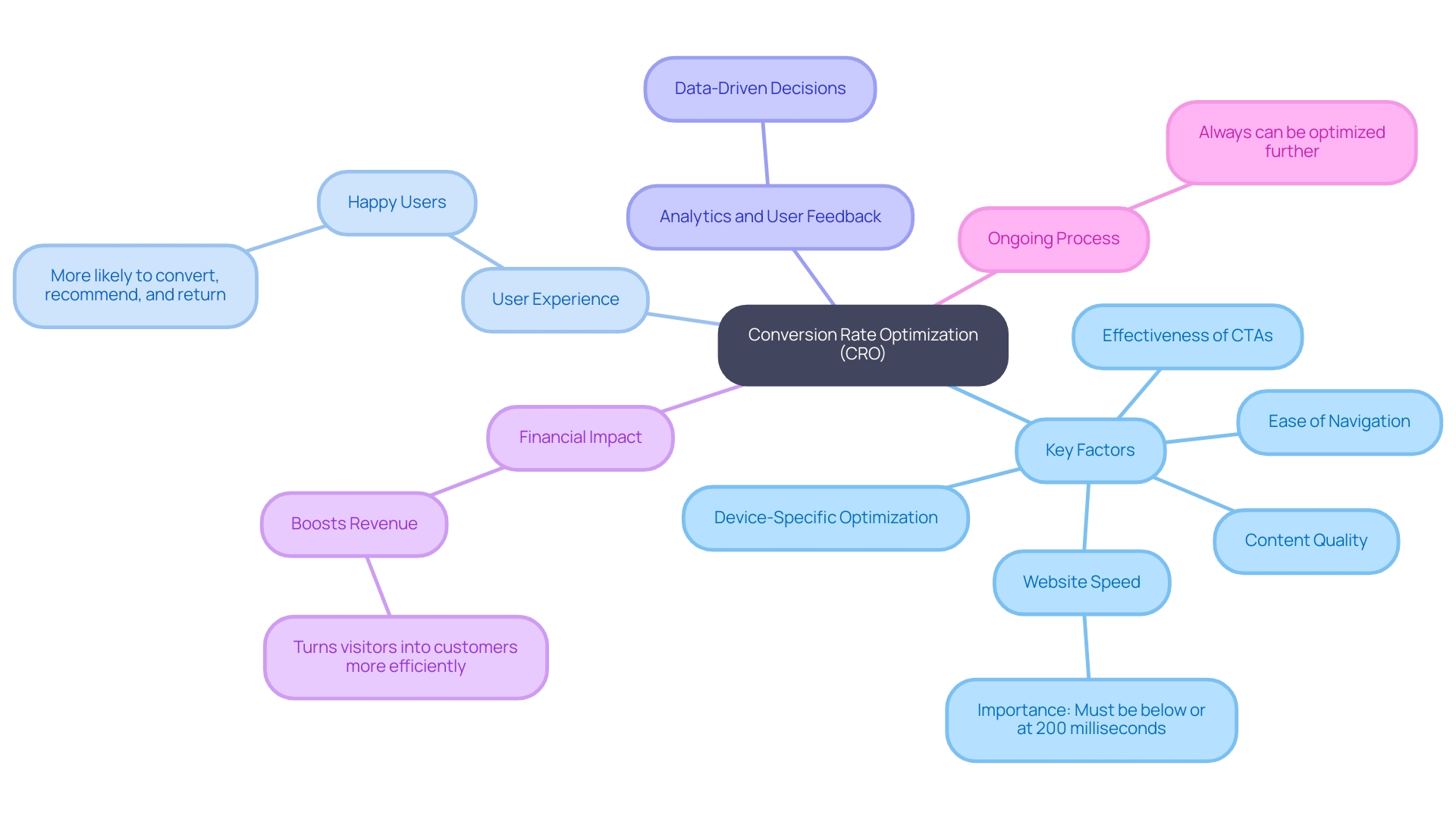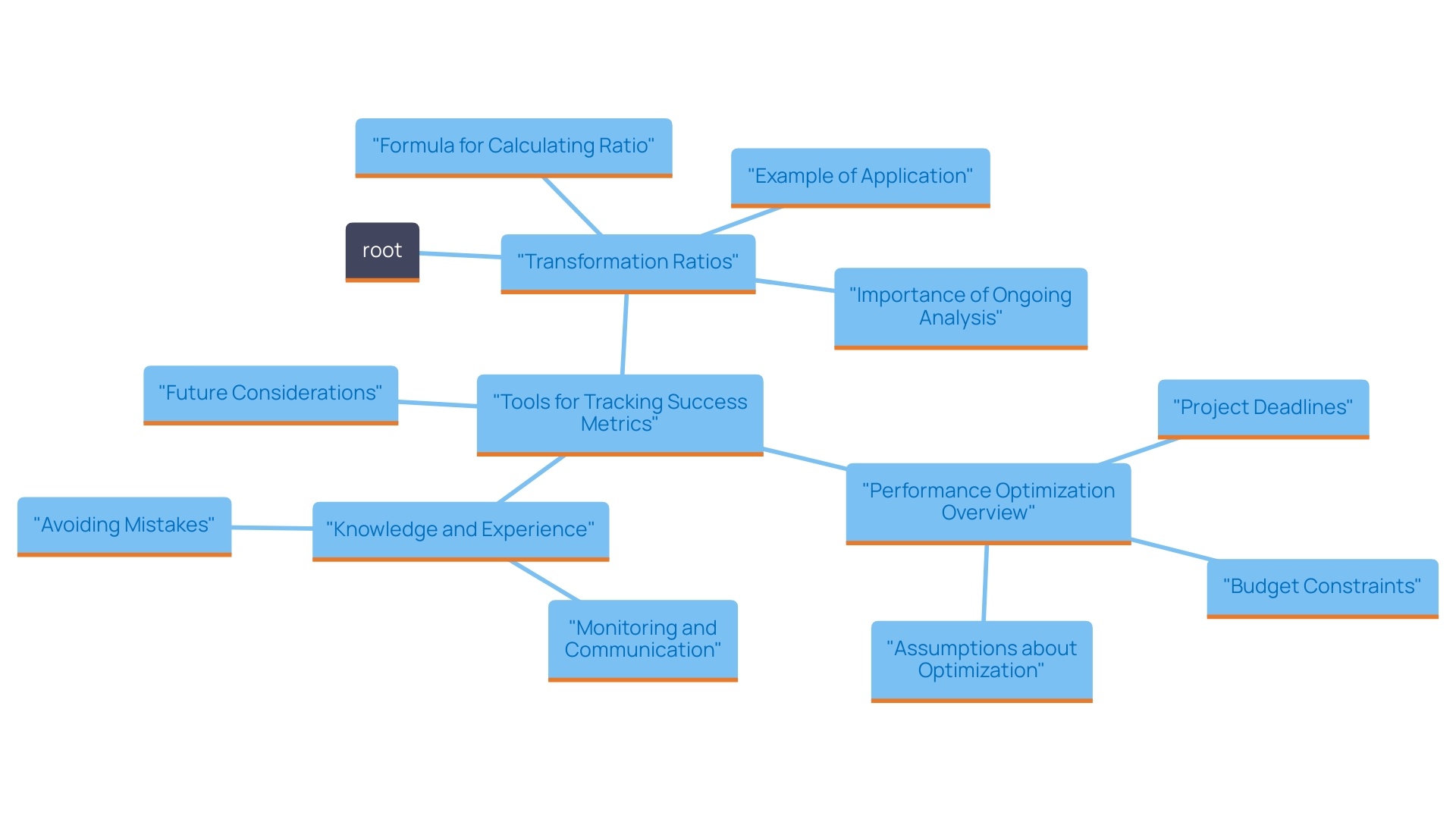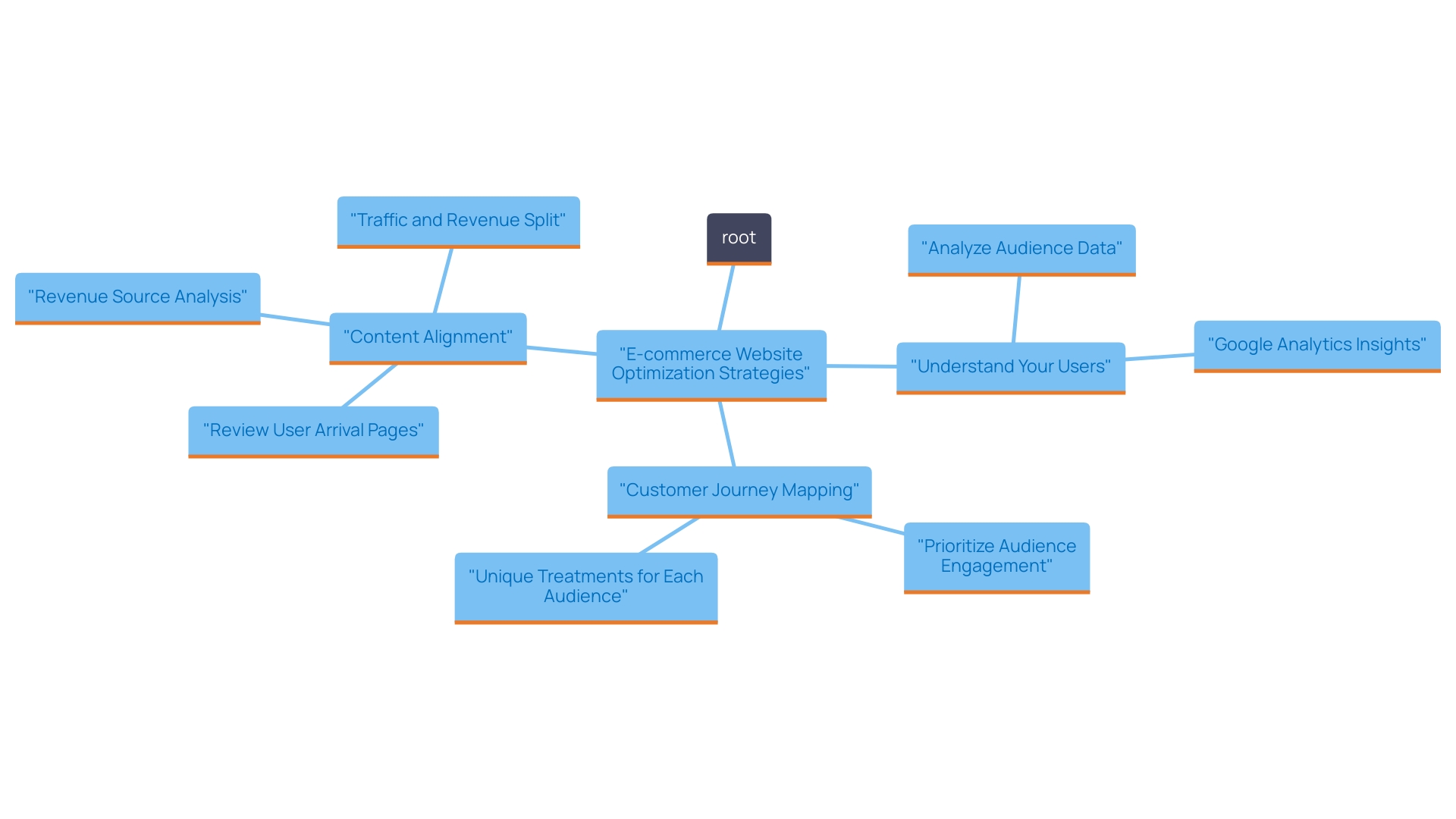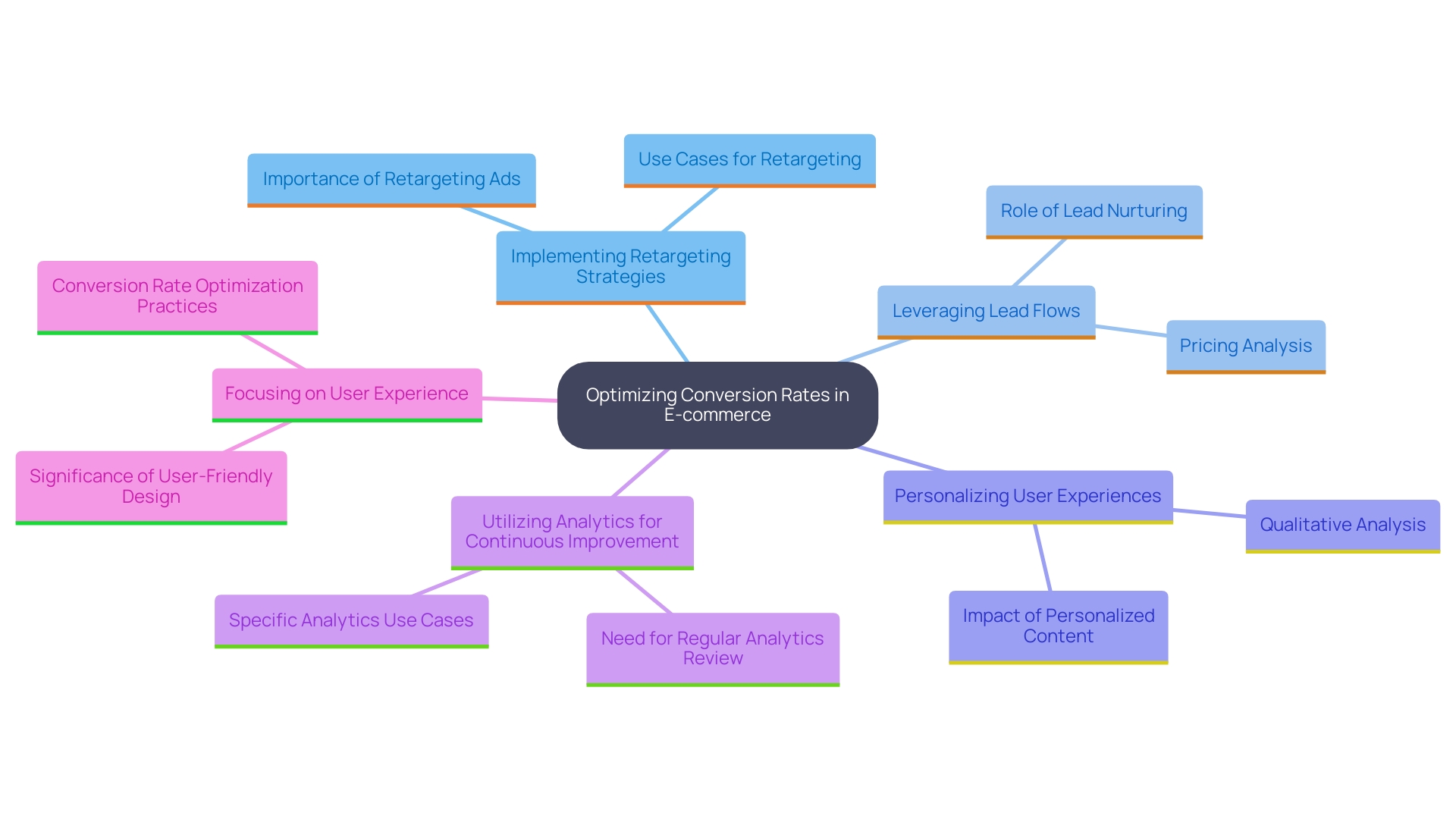Introduction
In the competitive landscape of digital commerce, mastering Conversion Rate Optimization (CRO) is essential for businesses aiming to transform casual visitors into loyal customers. As the online marketplace continues to evolve, understanding the nuances of CRO becomes increasingly vital. This article delves into the intricacies of optimizing web performance, revealing strategies that not only enhance conversion rates but also foster deeper connections with users.
From analyzing key metrics to implementing advanced techniques, the insights provided here will equip businesses with the tools necessary to thrive in a data-driven environment. By prioritizing user experience and leveraging tailored approaches, organizations can unlock significant growth and achieve sustained success.
Understanding Conversion Rate Optimization (CRO)
Conversion Rate Optimization (CRO) stands as a pivotal strategy for businesses aiming to maximize the percentage of website visitors who complete desired actions, such as making purchases or subscribing to newsletters. The significance of CRO is immense; it enables businesses to recognize and improve aspects of their web performance, ultimately increasing successful transactions.
Our custom e-commerce solutions, supported by over 20 years of global experience, have a proven track record of improving critical KPIs for our clients. This vast knowledge allows us to help companies not only in enhancing their success metrics but also in building community value by creating products that connect with individuals and align with internal goals.
Recent statistics highlight the critical need for device-specific optimization. For instance, during the second quarter of 2022:
- Desktop users converted at an average percentage of 3%
- Smartphone users lagged at 2%
This data underscores the potential benefits of a tailored approach to mobile traffic. In contrast, interstitial ads within iOS apps show an impressive average success percentage of 14.3%, highlighting the effectiveness of mobile advertising strategies.
Several key factors significantly influence CRO, including:
- Website speed
- Ease of navigation
- Content quality
- Effectiveness of calls-to-action (CTAs)
As industry expert Erin observes, "Comprehending these factors is essential for enhancing success metrics and guaranteeing sustainable growth in an increasingly competitive market."
By carefully enhancing these components and utilizing our unmatched proficiency in e-commerce solutions, businesses can attain significant advancements in their success metrics. As we delve into more advanced strategies in the following sections, grasping these foundational principles will be essential for driving effective CRO initiatives.

Calculating and Analyzing Conversion Rates
To efficiently determine your transformation ratio, use the following formula:
Transformation Ratio = (Number of Changes / Total Visitors) x 100.
For example, if your website drew 1,000 visitors in a month and 50 made a purchase, your success percentage would be determined as (50 / 1000) x 100 = 5%.
Understanding this formula is just the beginning. Consistently examining transformation metrics over time is essential as it allows you to assess the influence of changes made to your website. For instance, if you adopt a new design or marketing plan, monitoring alterations in success metrics can assist you in evaluating effectiveness.
Utilizing advanced analytics tools, such as Google Analytics or HubSpot, to monitor these metrics is essential. Additionally, categorizing your data by different traffic sources can show which channels are generating the highest success levels. This detailed analysis not only uncovers valuable insights into user behavior but also allows you to refine your marketing strategies to align with consumer engagement trends.
As Ronald Coase aptly remarked, 'If you torture the data long enough, it will confess to anything,' underscoring the importance of diligent analysis in achieving your business objectives. By committing to ongoing assessment and utilizing suitable tools, you can significantly improve your optimization efforts.

Key Strategies for Optimizing Web Pages for Conversion
-
Enhance Page Load Speed: Ensuring rapid page load times is essential, as research indicates that a single second delay in loading can result in a staggering 7% decline in sales. Employ tools such as Google PageSpeed Insights to pinpoint and rectify loading issues efficiently. Consistent performance evaluation is crucial for pinpointing areas for enhancement, ultimately improving the experience and increasing conversion rates.
-
Optimize for Mobile: Given that a significant share of e-commerce traffic now originates from mobile devices, it is imperative to prioritize mobile optimization. Implement responsive design principles and rigorously test experiences across various devices. Mick Russotti emphasizes, 'By investing in mobile optimization, you can ensure that your business remains relevant and competitive in the ever-evolving digital marketplace.' Companies that enhance their mobile experiences not only meet audience expectations but also stay ahead of competitors, ensuring ongoing relevance. For instance, a recent case study demonstrated that a retail company, after optimizing its mobile site, saw a 30% increase in mobile transactions within three months.
-
Enhance Call-to-Action (CTA): Develop clear and compelling CTAs that effectively guide individuals toward desired actions. Experiment with different colors, placements, and wording to determine what resonates best with your audience. Best practices include using action-oriented language, ensuring visibility above the fold, and creating a sense of urgency. A well-organized CTA can greatly influence audience participation and success metrics.
-
Utilize Trust Signals: Build credibility by incorporating customer reviews, testimonials, and trust badges within your web pages. These elements serve as powerful trust signals that can greatly influence purchasing decisions. Exhibiting such signals has been demonstrated to boost client confidence, which directly relates to heightened completion rates.
-
A/B Testing: Engage in A/B testing for various components on your web pages, including headlines, images, and CTAs. This approach allows you to discern which versions yield better performance, enabling continuous website optimization. By incorporating the latest strategies for optimizing web pages, you can ensure that your site stays competitive and efficient in generating results.

Advanced Techniques and Expert Tips for Effective CRO
-
Implement Retargeting Strategies: Retargeting ads serve as powerful tools for re-engaging visitors who have left your site without making a purchase. These strategic reminders can significantly improve engagement opportunities by directing individuals back to your offerings. In today's competitive landscape, retargeting is not merely an option but a necessity for maximizing marketing ROI, especially for those individuals who may not return otherwise.
-
Leverage Lead Flows: Designing effective lead flows allows you to capture valuable visitor information in exchange for enticing content or discounts. This approach not only boosts your lead generation efforts but also fosters a relationship with potential customers, making them more likely to convert. Rachelle Gordon, a Senior Writer and Business Strategy Expert, notes, "Email customers are committed and reliable customers," emphasizing the importance of nurturing leads through effective communication.
-
Personalization: Harness the power of data to create personalized experiences on your website. By customizing content and product suggestions according to individual behavior, you can significantly enhance engagement and conversion figures. For instance, research indicates that personalized emails can increase click-through rates by up to 14%, illustrating the effectiveness of this approach. A prime example of this is seen in Netflix's retargeting strategy, where personalized messaging—such as notifications about new seasons of previously watched shows—has proven to enhance viewer interaction. Their effective use of dual calls to action (CTAs) like 'watch now' or 'save for later' doubles the likelihood of engagement.
-
Utilize Analytics for Continuous Improvement: Regularly analyzing behavior data is vital for identifying drop-off points within your sales funnel. This insight allows you to refine and improve your web pages continuously, ensuring that you address any obstacles that may impede the process.
-
Focus on User Experience (UX): Investing in user experience design is crucial for creating a seamless and enjoyable browsing environment. A well-organized website that is user-friendly and simple to navigate can have a significant effect on your success metrics. By prioritizing UX, you not only enhance customer satisfaction but also drive higher levels of engagement and achievement.
Conclusion: In conclusion, implementing advanced retargeting approaches, leveraging effective lead flows, personalizing user experiences, utilizing analytics for continuous improvement, and focusing on user experience are essential components for optimizing conversion rates in e-commerce. By adopting these strategies, you can significantly enhance your marketing ROI and foster lasting relationships with your customers.

Conclusion
The journey toward mastering Conversion Rate Optimization (CRO) is both critical and rewarding for businesses in the digital landscape. By understanding the foundational elements of CRO, including website performance, user experience, and effective calls-to-action, organizations can significantly enhance their ability to convert casual visitors into loyal customers. The importance of device-specific optimization and the impact of page load speed cannot be overstated; these factors directly influence user engagement and, ultimately, conversion rates.
Moreover, employing advanced strategies such as retargeting, personalized experiences, and continuous data analysis further empowers businesses to refine their approaches and meet evolving consumer expectations. By prioritizing user experience and leveraging insightful analytics, companies can not only drive higher conversion rates but also cultivate a loyal customer base that values their offerings.
In a rapidly changing digital marketplace, the commitment to optimizing conversion rates is essential. Embracing these strategies positions businesses for sustained growth and success, ensuring they remain competitive and relevant. The path to effective CRO is paved with insights, data-driven decisions, and an unwavering focus on the user journey—elements that collectively unlock the potential for significant business impact.





